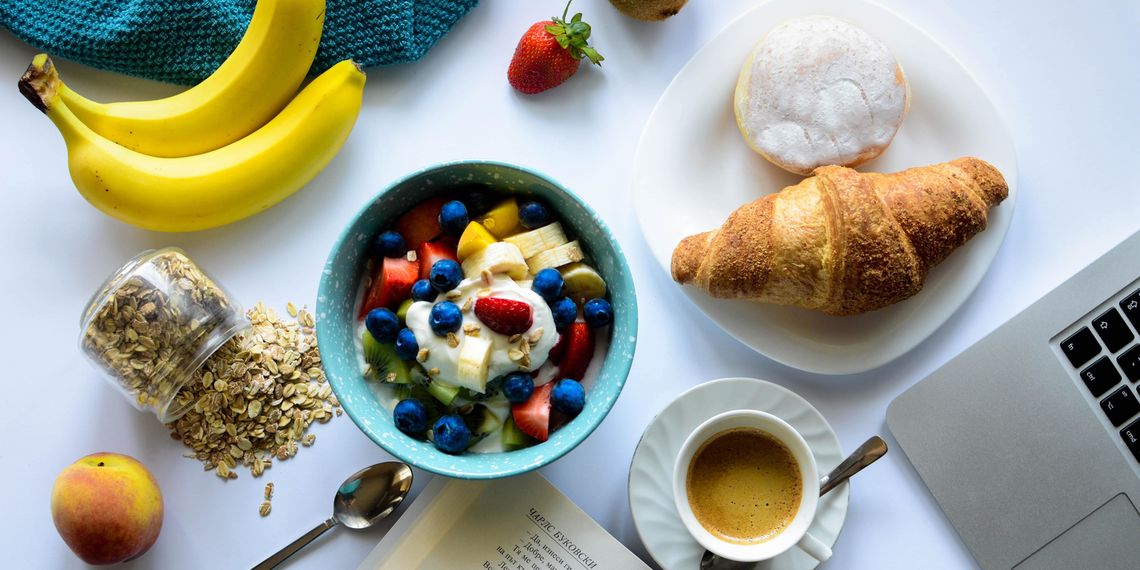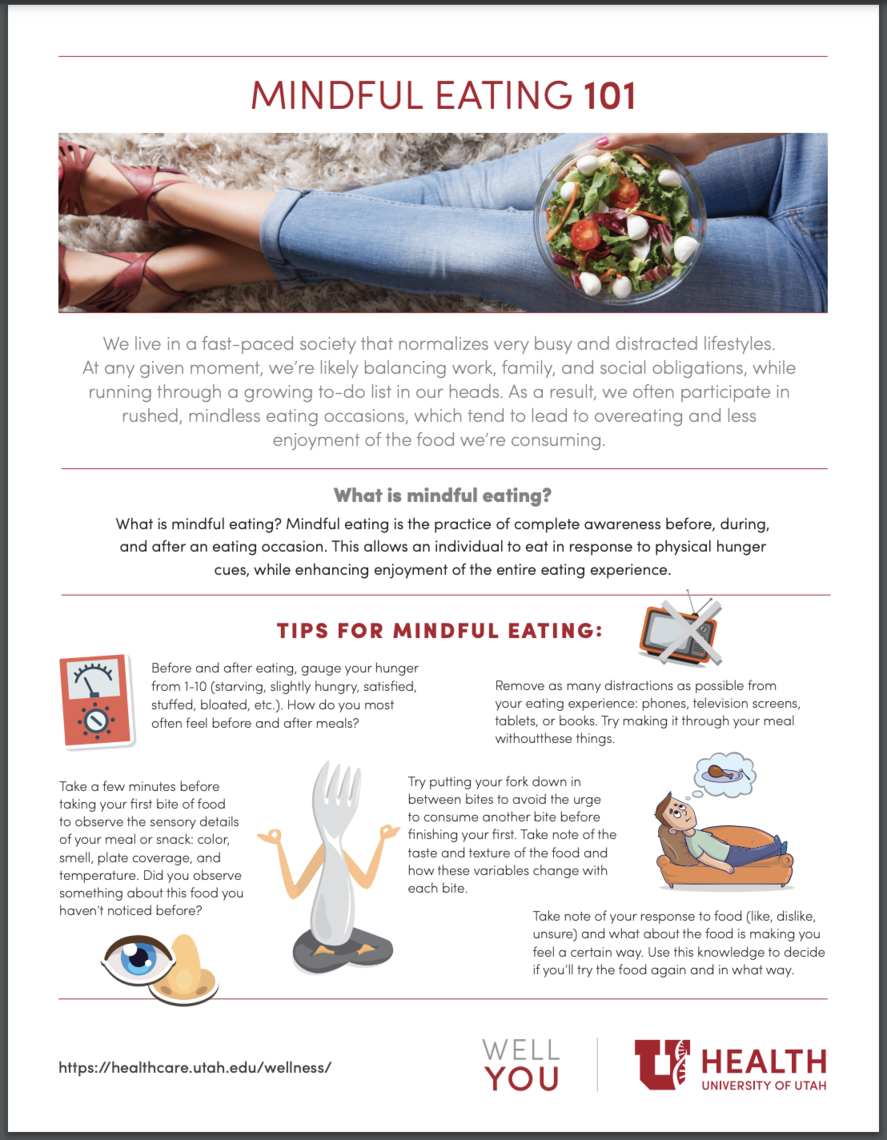ffice eating culture” is the practices, attitudes, and behaviors we hold around eating in the workplace. It is important to start the conversation around office eating culture because on average we spend 13 years or 90,000 hours at work across the lifespan – and we eat about every 3-5 hours during the day.
Food choices in the workplace are tied to focus, mood, and productivity. Most importantly, though, is our value of one another’s health. Because health looks different for everyone, we must come together in an office to see what works well for those inhabiting it. Let’s explore some practical ways everyone in the workplace can be involved.
Who should be onboard and how to talk about it:
- Managers: Encouraging and offering nutrient-dense (i.e., a food item that is high in nutrients relative to its weight) options at meetings or celebrations not only says, “We care about your health and wellbeing”, but also, helps to increase productivity and focus. By decreasing simple carbohydrate intake, we decrease sugar crashes and maintain a steady energy state throughout the workday. Providing nutrient-dense options is a great way to care for your employees.
- Administrative personnel: There are plenty of nutritious catering options around the U and they really aren’t much more expensive – if at all! Because we are often unaware of employee dietary restrictions or health goals, it is best to provide nutrient-dense meal options. These include vegetable and hummus platters, salad varieties, and whole-wheat pastas. When in doubt, pick options that would include vegetables, whole grains, and a lean protein source.
- Coworkers: Take turns bringing nutrient-dense snacks to share. Have fun sampling new foods you may never have tried before. Everyone is invited to participate!
- Don’t forget your night/weekend colleagues: Those of us who work during daylight hours often overlook our colleagues who share our same spaces at night and during the weekends. Think creatively about how to extend the party or provide fresh food access for night/weekend teams.
THEN- Practice, practice, practice...
Listen to your own hunger cues
-
Practice checking in with your body and determining your level of hunger. Ask yourself: “What do I need in this moment?”. If your body is giving you hunger cues, you may need a snack. Or is your body telling you that it is already at a state of fullness? If snacks are brought to every meeting, you have the power to choose whether or not you wish to participate.
-
Here are other resources at the U that help build tools in mindfulness:
Transform office snacks
-
Transform the office space to have nutrient-dense snacks on hand. Set a new norm – For ideas, see “Office Eating Ideas” list below
What do you want to get from your food today?

Click here to learn more about what you can get from your food.
Ask coworkers their health goals
-
Ask how you can support one another in their goals and provide space for this discussion. It is important to practice respect here, as there is usually more to the picture behind our dietary choices. Learning about team members’ health goals is important.
-
For all of us it can be difficult trying new things. Talk with a coworker about how you could both try more nutritious alternatives together. The goal is to slowly warm-up to the idea of office eating options changing. What better way to prepare for this shift than to try new foods together?
Non-food Rewards
Some in the university are currently taking a good hard look at their recognition structure. Not only will they think about who should be recognized but will turn a focus on non-food rewards. When we truly care about our coworkers and team members, giving the gift of health and wellbeing in the form of a massage, nutrition consult, or team workshop can speak volumes.
Other ideas for non-food rewards your office could try include:
-
Longer Lunch Break for Walking–Could also be a great way to build friendships with your coworkers!
-
Dress-down Day Coupon
-
Handwritten Notes–A note is not only free, but thoughtful and classy. Words of affirmation can go a long way.
-
Office Flowers–Bring in a bouquet of flowers for the whole office to enjoy during the day. Then tell coworkers to take a few home at the end of the day!
Office eating ideas
Personally, I love to bake. Inviting a friend over to celebrate a birthday makes me so excited because it means I can try a new cake recipe and use sprinkles! Hear me out - sweets are not a “bad thing”. They are often part of celebrations and are a fun way to try new recipes. However, when sweets are often the only option of snacks brought into the office, that is when we may want to shift our baking habits.
After bringing in leftover baked goods to my office routinely, I realized some of my coworkers were monitoring various health conditions and all held different goals around these conditions. I realized that, yes, sharing baked goods (with sprinkles!) can be a special treat, routinely bringing them into the office was not being inclusive of all my coworkers. After realizing I may not be helping my coworkers towards their goals, I now try to choose recipes that are high in fiber (usually oats), include fruits or vegetables (think applesauce, zucchini, carrots, berries), and try to decrease the added sugar as much as possible. Here are some delicious recipes that you can feel good about sharing at work (or with your family).
Check out this list for creative ways to broaden the types of foods available at your office:
Office Snack Ideas to have on Deck:
-
Popcorn: Consider an office hot-air popcorn popper. Making your own is a great way to add fiber to your diet and you can choose how much salt is added. If you are limiting sodium in your diet, try these low-sodium add-ons: garlic powder with olive oil, chili powder with lime juice, nutritional yeast, or cinnamon
-
Nuts: Snack-sized packs of almonds or cashews with little to no salt added
-
Dried Fruit: snack-sized packs of dried mango, apples, or apricots with no sugar added
-
Hummus and Veggies: Purchase hummus packs and bring in Tupperware of washed and chopped carrots, celery, peppers, or tomatoes!
-
Cheese Sticks
-
Plain Yogurt: Check the label and choose one with less than 10 grams of added sugar. Bring your own added fruit for extra fiber and nutrients
Nutritious Local Catering Ideas:
-
Try out other catering options that include more nutrient-dense options. Ideas are Vessel Kitchen and Aubergine & Co.
Celebrations or Snack-worthy Meetings
When I have been tasked with brainstorming catering ideas in the past, I was able to put together an oatmeal bar with Chartwells on campus. In addition to massive vats of oatmeal, we were pleasantly surprised to have many mix-ins or toppings to choose from. We were able to add fresh fruit, crunchy granola, and nuts! Here’s some other healthier food buffet ideas:
-
Sparkling Water Bar
-
Provide sparkling waters, whether plain or a no-sugar flavor brand like La Croix. Set up a variety of fresh barriers, lemon slices, lime slices, and mint to build your own sparkling water
-
-
Trail Mix Bar
-
Provide a variety of nuts: walnuts, cashews, almonds, peanuts (all with no salt added). Also provide sunflower seeds, any type of dried fruit (with no sugar added), low-sugar granola and dark chocolate chips.
-
-
Veggie Buffet
-
Provide chopped vegetables, like celery, carrots, cauliflower and broccoli. Then provide a variety of hummus options, tahini dip, and Greek-yogurt ranch dip
-
It may also be helpful to provide some dark chocolate squares (>75% cocoa) for the sweet-tooth folks!
-
Originally published May 2022
Britta Trepp
Helen Hardy
Health care delivery is ripe for digital disruption. How are we preparing for the future at U of U Health? Chief Information Officer Donna Roach outlines the path forward and what it takes to transform health care to meet an increasingly digital future.
“This is why I went into medicine—to talk to my patients and show them humanity.” In the rapid day-to-day clinical setting, that’s harder to find. Utah Advanced Communication Training (UACT) provides practical tools to enhance patient and peer interactions.
The crises of Covid-19 and police brutality have highlighted systemic racial inequity in the United States and the need to consciously dismantle the forces that cause racial health disparities. PA students Scarlett Reyes and Jocelyn Cortez brought together Black patients at the University of Utah to share their experiences. Their advice: build cultural competence and be mindful of microaggressions.


